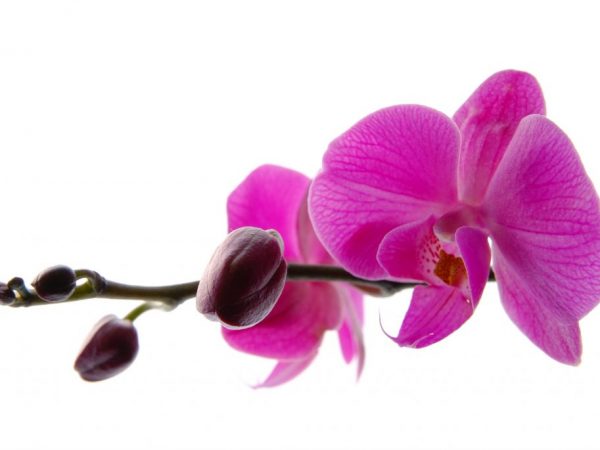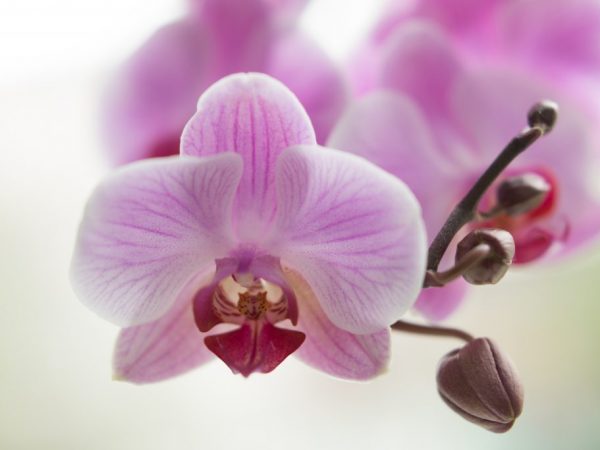Reasons for dropping buds in orchids
Orchids are considered whimsical plants to care for. A home flower is sensitive to temperature conditions, humidity, and even a planned transplant or reproduction. For flower growers, a problem is the situation when the buds of an orchid fall off. There are many reasons for this, and all require a solution.

Reasons for dropping buds in orchids
Common Causes
Phalaenopsis is considered the most common type of flower.
All the reasons why buds crumble (sometimes even unblown ones) are the same for all types of flowers.
The main reasons why the buds of phalaenopsis fall off:
- proximity to unwanted fruits or plants;
- change of temperature, humidity, lighting regime;
- improper watering;
- fertilizing with fertilizers during flowering;
- stressful situation (transplant, move);
- natural old age.
Some reasons why an orchid bud withers cannot be resolved. Some require analysis and adjustment.
Watering mode
The reason why the buds of an orchid fall off is improper watering.
From overflow or underfilling, the flower prematurely sheds its buds. This is due to decay or dryness of the root system. The flower gradually dies, it does not have the strength to bloom.
To avoid this, follow the flower irrigation schedule. Determining when a culture needs water is simple: touch the ground with your finger. Wet soil does not require watering, dry soil is moistened.
Temperature, humidity, lighting
These 3 factors are key to keeping a plant at home. At the slightest violation of the conditions, the flower drops leaves and flowers. In poor conditions, the buds of an orchid do not bloom, and those that appear over time dry up and fall off.
Optimum indicators for a plant:
- Temperature - 20 ° C to 27 ° C will be the best for the plant. In winter, the flower is dormant, and blooms in spring and summer. Both going down and up will cause the buds of the orchid to fall off.
- Humidity should not exceed 75%. A high level of moisture leads to a change in plant behavior, accelerated decay. Insufficient leads to drought.
- Lighting is an important point in flower care. If leaves or flowers fell off when the orchid stood on the windowsill in direct light, this means that they have burned out. Also, with a lack of light, the plant decides not to bloom, and the buds, without blooming, fall off. When a bud withers, it can no longer be reanimated.

Create favorable conditions for the flower
To avoid falling buds, take care of creating favorable conditions (especially in summer and winter):
- In the summer, the flower is removed to a cool room, but not placed under an air conditioner: drafts are also the cause of the ovary falling off. Avoid the scorching sun, put the flowerpot in a bright, but slightly darkened place.
- In winter, the flower is not placed near heating appliances. Heaters and batteries heat the air and reduce humidity. Avoid keeping the plant in low temperature conditions, especially at sub-zero temperatures.
During the move, be sure to prepare in advance conditions similar to the previous ones. A change in setting adversely affects the flower, and the buds of the orchid fall off.
Other factors
Additional reasons that the buds of an orchid fall off are old age, untimely feeding, transplantation and improper neighborhood:
- The buds of the orchid, which were fed during the flowering period, fall off. This is fundamentally wrong: during this period, the flower is full of strength and does not perceive fertilizer.
- Repotting is a common reason why an orchid sheds its buds prematurely. If the ovary withers or flowers do not bloom, the new soil, conditions, or it has a period of adaptation is not suitable for the plant.
- An orchid prematurely sheds its buds if it has already passed the age of active flowering. Signs of old age: she has thrown off the lower leaves, flower ovaries appear and fall without blossoming; the leaves turn yellow and fall off.
- Neighborhood with other plants. There is an opinion that the flower does not tolerate the neighborhood with ripening apples, bananas and tomatoes. Tobacco smoke definitely negatively affects the plant.
Phalaenopsis is considered the age of old age 4-5 years. A plant can refuse flowering due to illness. In order to identify signs in time, preventive measures are taken.
How to help a plant to bloom
Some orchids need to be placed in a stressful situation in order for them to bloom. It is created only for flowers that have ceased to bloom, although the conditions have remained unchanged. In the summer, try the following:
- On a warm night (about 16 ° C), the flowerpot is taken out onto the balcony. They leave him there until morning. Then they return to the previous conditions.
- If the plant is resistant to weather conditions, it is kept on the balcony in good weather for 2 weeks. The mode of watering and spraying is left the same.
- In the period before the expected flowering, the amount of water in irrigation is reduced. This dries the roots a little and stimulates them to bloom.
All these methods are tried when objective reasons are excluded.
If the plant is old, weak or in unfavorable conditions, the stressful situation aggravates the situation, leading to death or disease of the flower.
Conclusion
If the buds of the plant dry up and crumble, this indicates improper care or the old age of the orchid. It is important to create an optimal temperature regime, humidity level and adjust lighting; carry out feeding and transplanting during periods favorable for the plant.
Also, the flower buds fall off if it has recently experienced stress or was in adverse conditions. Old age begins after 4-5 years of active flowering.


